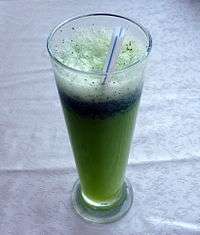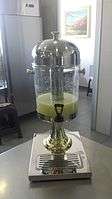Lemonade
Lemonade can be any variety of sweetened or unsweetened beverages found throughout the world, which are traditionally all characterized by a lemon flavor.[1]
Most lemonade varieties can be separated into two distinct types: cloudy and clear; each is known simply as "lemonade" (or a cognate) in countries where dominant.[2] Cloudy lemonade, generally found in North America and South Asia, is traditionally a homemade drink using lemon juice, water, and a sweetener such as cane sugar, a simple syrup (white sugar and water) or honey.[3] In the United Kingdom and Australia, clear lemonade, which is typically also carbonated, dominates.[2]
The suffix "-ade" may also be applied to other similar drinks made with different fruits, such as limeade, orangeade, or cherryade.[4]
History
As lemons and sugarcane are native to India, the Indians first consumed a type of lemonade called nimbu pani.[5]
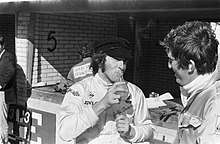
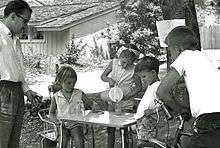
The earliest written evidence of lemonade has been found in Egypt, dated to around AD 1000. It is believed that the fruit was introduced from Asia around AD 700.[6] Here, a drink made with lemons, dates, and honey was enjoyed by peasants, and bottles of lemon juice with sugar, known as qatarmizat were imported and consumed locally.[7]
In 1676, a company known as Compagnie de Limonadiers was founded in Paris.[8] Having been granted monopoly rights to sell lemonade, vendors roamed the streets serving the drink in cups from tanks on their backs.
While carbonated water had been invented by Joseph Priestley in 1767, the first reference found to carbonated lemonade was in 1833 where the drink was widely available in British refreshment stalls.[9] R. White's Lemonade, which is now produced and sold by Britvic, has been sold in the UK since 1845.[10]
Varieties
Cloudy lemonade
The predominant form of lemonade found in the US, Canada, and India, cloudy lemonade, also known as traditional or old fashioned lemonade in the UK and Australia, is typically non-carbonated and made with fresh lemon juice; however commercially produced varieties are also available. Generally served cold, cloudy lemonade may also be served hot as a remedy for congestion and sore throats,[11] frozen, or used as a mixer.
Traditionally, children in US and Canadian neighborhoods start lemonade stands to make money during the summer months. The concept has become iconic of youthful summertime Americana to the degree that parodies and variations on the concept exist across media. References can be found in comics and cartoons such as Peanuts, and the 1979 computer game Lemonade Stand.[12]
Pink lemonade
A popular variation of cloudy lemonade, pink lemonade, is created by adding additional fruit juices, flavors, or food coloring to the recipe. Most store bought pink lemonade is simply colored with concentrated grape juice or dyes.[13]
A 1912 obituary, credited the invention of pink lemonade to circus worker Henry E. "Sanchez" Allott, saying he had dropped in red cinnamon candies by mistake.[14]
An earlier and possibly more likely origin story credits another circus worker, Pete Conklin, in 1857. His brother, George Conklin tells the story in his 1921 memoire. According to the story, Conklin's lemonade was a mixture of water, sugar, tartaric acid, with the tub garnished with a single lemon that he repeatedly used for the season. One day, he ran out of water. Searching desperately, he found a tub of water a bareback rider had recently used to rinse her pink tights. Adding in the sugar, acid and remaining bits of lemon, he offered the resulting mixture as "strawberry lemonade", he saw his sales double.[13][15]
Clear lemonade
The predominant form of lemonade in the UK and Australia is a clear, lemon-flavoured carbonated beverage. Schweppes and R. White's Lemonade are common brands, and shops usually carry a store branded lemonade as well.[10] Schweppes uses a blend of lemon and lime oils.[16] Other fizzy drinks (or pop) which are both lemon and lime flavoured may also sometimes be referred to as lemonade, such as Sprite and 7 up. There are also speciality flavours, such as Fentimans Rose Lemonade, which is sold in the UK, the US, and Canada. Shandy, a mixture of beer and clear lemonade, is often sold pre-bottled, or ordered in pubs.
Brown lemonade
There are various drinks called brown lemonade. In Northern Ireland, brown lemonade is flavoured with Brown sugar.[17] A variant from Venezuela has cane sugar and lime.[18]
Other varieties
In India and Pakistan, where it is commonly known as nimbu paani, and in Bangladesh, lemonades may also contain salt and/or ginger juice. Shikanjvi is a traditional lemonade from this region, and can also be flavored with saffron, cumin and other spices.[19][20][21]
Limonana, a type of lemonade made from freshly squeezed lemon juice and mint leaves, is a widely popular summer drink in Israel, Jordan, Lebanon, and Syria.[22] Limonana was created in the early 1990s in Israel after an advertising agency promoted the then-fictitious product to prove the efficacy of advertising on public buses. The campaign generated so much consumer demand that restaurateurs and manufacturers began really producing the drink, which would become very popular.[23][24] In Northern Africa, a drink called cherbat is made of lemon, mint, and rose water.
Switcha is a version of the drink made in the Bahamas and Turks & Caicos that can also be made with limes instead of lemons.
Citron pressé
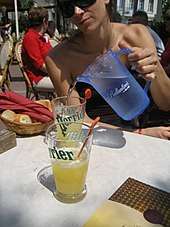
In France, it is common for restaurants to offer citron pressé, an unmixed version of lemonade in which the customer is given lemon juice, syrup and water separately to be mixed in their preferred proportions.[25]
Health effects
The high concentration of citric acid in lemon juice is the basis for popular culture recommendations of consumption of lemonade to prevent calcium-based kidney stones. Studies have not demonstrated that lemonade causes a sustained improvement of urine pH, increased citric acid concentration in urine, reduction in supersaturation by stone-forming salts, or prevention of recurrent stones.[26]
See also
- Hard lemonade
- Lemonade cocktail
- Lemon-lime drink
- Lemon squash
- Lemon, Lime and Bitters
- Chanh muối
- List of juices
- List of lemon dishes and beverages
- Ramune
- When life gives you lemons, make lemonade
References
- "LEMONADE - meaning in the Cambridge English Dictionary". dictionary.cambridge.org.
- Muir, Alana (2012). An American Guide to Britishness. Lulu.com. ISBN 978-1-4717-8546-7.
- "History of Lemonade". Buzzle. Archived from the original on October 9, 2015. Retrieved December 26, 2015.
- Smith, Andrew F. (October 28, 2013). Food and Drink in American History: A "Full Course" Encyclopedia. ABC-CLIO. ISBN 978-1-61069-233-5.
- "Nimbu Pani". Oxford Dictionaries.
- "The History of Lemonade". www.frontiercoop.com. Archived from the original on December 27, 2015. Retrieved December 26, 2015.
- "Did You Know: Food History – History of Lemonade". www.cliffordawright.com. Archived from the original on March 12, 2012. Retrieved December 26, 2015.
- "The Victoria Advocate – Google News Archive Search". news.google.com. Retrieved December 26, 2015.
- Emmins, Colin (1991). SOFT DRINKS – Their origins and history (PDF). Great Britain: Shire Publications Ltd. p. 8 and 11. ISBN 0-7478-0125-8.
- "Chester homeless charity teams up with lemonade brand". Chester Chronicle. October 8, 2017.
- "Is Lemonade Good for Sick People to Drink While They Have the Flu?". LIVESTRONG.COM. Retrieved December 26, 2015.
- Apple Computer (1979), Lemonade Stand (1979) (Apple), retrieved May 3, 2020
- "The Unusual Origins of Pink Lemonade | History | Smithsonian". Smithsonianmag.com. August 16, 2016. Retrieved October 13, 2019.
- "Inventor of pink lemonade dead" (PDF). New York Times. September 18, 1912. p. 11. Retrieved September 21, 2007.
- Nickell, Joe. Secrets of the Sideshows, 978-0813123585, University Press of Kentucky, 2005. pp. 31-32.
- Product description
- "Brown Lemonade". CooksInfo. Retrieved March 18, 2020.
- Locklin, Kristy (October 18, 2020). "Cilantro & Ajo brings Venezuelan street food to Pittsburgh's South Side". Next Pittsburgh.
- Jiggs Kalra, Pushpesh Pant, Classic cooking of Punjab, Allied Publishers, 2004, ISBN 978-81-7764-566-8
- Julie Sahni, Indian regional classics: fast, fresh, and healthy home cooking, Ten Speed Press, 2001, ISBN 1-58008-345-5, 9781580083454, "... Ginger Limeade (Shikanji) ..."
- Mint lemonade / pudina shikanji / pudina nimbu paani / masala lemonade. Indian Recipe Secrets. June 16, 2018. Retrieved August 29, 2018.
- "Limonana: Not your average lemonade". Zomppa. August 29, 2011. Archived from the original on March 26, 2019. Retrieved May 28, 2012.
- Martinelli, Katherine (July 11, 2011). "Limonana: Sparkling Summer". Jewish Daily Forward. Retrieved May 28, 2012.
- Siegal, Lilach (May 29, 2001). לימונענע וירטואלית [Virtual Limonana]. The Marker (in Hebrew). Retrieved May 28, 2012.
- Rough Guides Snapshot (April 12, 2012). Poitou-Charentes and the Atlantic Coast Rough Guides Snapshot France (includes Poitiers, La Rochelle, Île de Ré, Cognac, Bordeaux and the wineries). Rough Guides Limited. p. 96. ISBN 978-1-4093-6293-7.
- Zisman, Anna L. (2017). "Effectiveness of Treatment Modalities on Kidney Stone Recurrence". Clinical Journal of the American Society of Nephrology. 12 (10): 1699–1708. doi:10.2215/CJN.11201016. ISSN 1555-9041. PMID 28830863.
External links
| Wikibooks Cookbook has a recipe/module on |
| Wikimedia Commons has media related to Lemonade. |
- Of the Street Sale of Ginger-Beer, Sherbet, Lemonade,&C., from London Labour and the London Poor, Volume 1, Henry Mayhew, 1851; subsequent pages cover the costs and income of street lemonade sellers.
